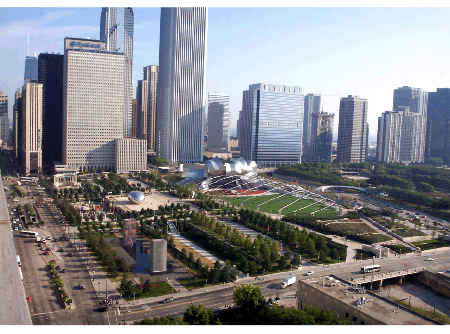People adore parks. Most people also love open space. That applies even to the three Grand Traverse (MI) County commissioners who last month suggested that global climate change was a leftist conspiracy ginned up by Al Gore, and suggested that emailing the sun was a useful antidote.Â
Parks and open space provide the same economic benefits as shorelines and water views. They increase property values and tax revenues. They also cost muncipalities and taxpayers far less money to manage than neighborhoods and business districts. The short course for the finance majors among us: parks and open space offer communities a great return on investment.
Smart cities, as Chicago, Portland, Salt Lake City, New York, Boston, St. Louis and countless others have learned, build and maintain excellent park systems because they pay back everything and more that’s put into them. Chicago’s Millennium Park (see pix) cost $475 million to build, which initially was a source of irritation to some taxpayers. But the park also has helped to prompt a housing construction boom in nearby neighborhoods that for decades experienced almost no new development. More than 10,000 units of new housing have been built or are permitted around the new park, generating millions in new revenue for city coffers. Millenium Park, by the way, is actually the largest green roof in the world, spanning an underground parking garage and a railroad right of way that had separated Michigan Avenue from Lake Michigan for over a century.  Â
According to the Trust’s study, The Economic Benefits of Land Conservation, city planners and business leaders have long recognized the social and financial value of great parks. At the turn of the 20th century, several studies found that the market value of properties located near parks and open space were higher than those of comparable properties located elsewhere. That’s still true.
The grand West Side apartments overlooking New York City’s Central Park sell for more and generate more city property tax revenue than similar large apartments overlooking West End Avenue. Planners call this the “proximate principle,” a nifty way of saying if you’re lucky enough to buy a house close to a park – within 600 feet of an urban park and 1,500 feet of a large natural reserve, says the Trust — you’ve usually made a good investment.Â
A 2001 study of more than 16,000 single family home sales in Portland, Oregon, found that 16 percent of the value of properties located within 1,500 feet of a natural reserve were due to their proximity to the park. A study in 1978 in Boulder, Colorado found that a neighborhood of homes close to that city’s greenbelt was worth $5.4 million more than a similar neighborhood farther away.
Nor is the increase in property values and the attendant increase in tax revenues the only benefits of parks and open space. They also cost less to operate and maintain. Wayland, Massachusetts found that developing 1,250 acres of open space within its jurisdiction would cost $328,350 more each year than the tax revenues the city would gain from new homes. “A strategy of conserving parks and open space is not contrary to a community’s economic health,” concluded the authors of the Trust study,” but rather is an integral part of it.”


Your discussion of Millennium Park is absurd. The neighborhoods around the park have been adding high-priced units for 2 decades. The South Loop was already gentrifying in 1988.
I’m not against green space, and I’m certainly no anti-global warming lunatic. But you have to get the numbers right.
Millennium Park is an example of just the opposite — a city spending inordinate amounts of money on a downtown full of yuppies, while many neighborhoods are starved for greenspace. And Millennium Park was ALREADY a park anyway. If anything, there is less green space there now as a result of all the things that now have footprints over there — the dance theater, the expanded music shell, the Park Grille (a corrupt deal that typifies the city’s political culture – as well as a crappy, ugly little bar taking up prime real estate.)
Ne plus ultra:
I stand by the reporting and don’t find evidence of your assertions about development around the park or its use. The area south of the park, behind the Hilton, and even along South Michigan had been in decline for years. It is no longer and its revival coincides with the planning, design, construction, and opening of the park. In interviews, city officials confirmed what the new housing permit numbers were already saying. Millennium Park was prompting a new wave of growth. So there you have it, the facts as portrayed in city data and your own impressions and attitudes which differ. Thanks for writing, Keith
Fantastic goods from you, man. I have remember your stuff prior to and you are simply extremely excellent. I really like what you have got right here, certainly like what you are stating and the best way during which you say it. You are making it enjoyable and you still take care of to keep it wise. I can not wait to read much more from you. That is actually a tremendous website.|